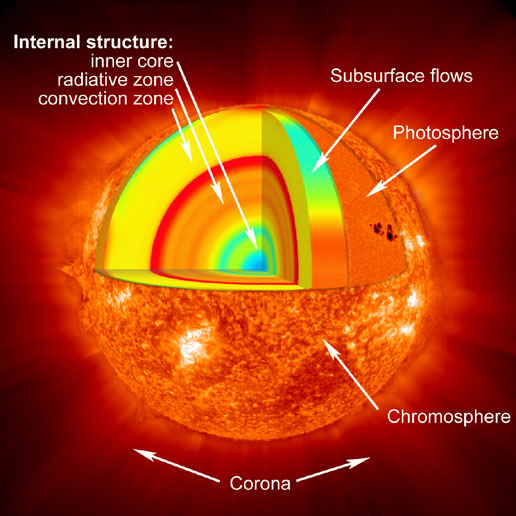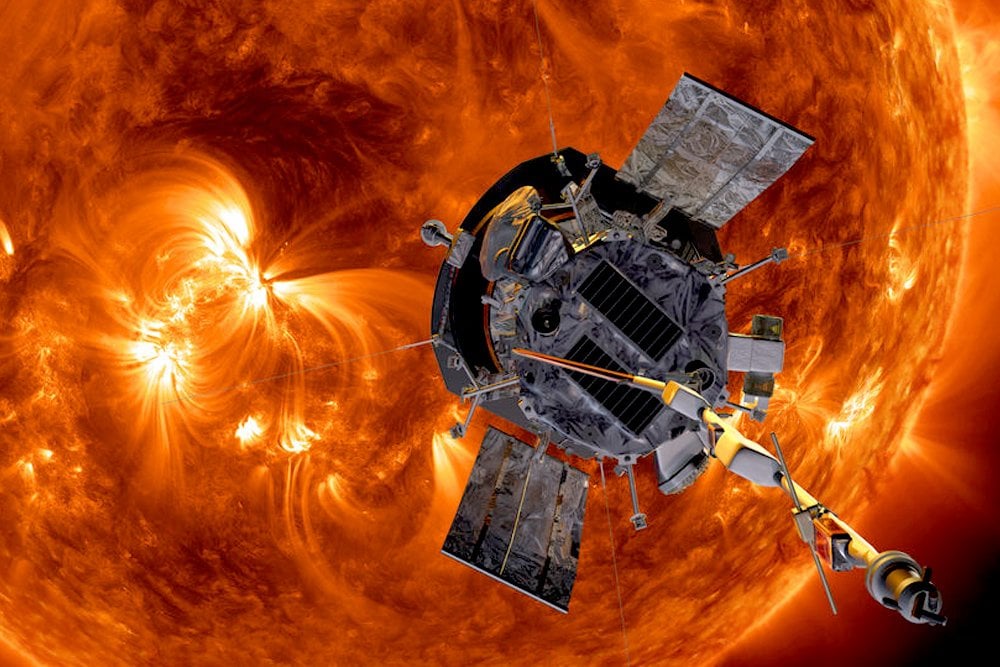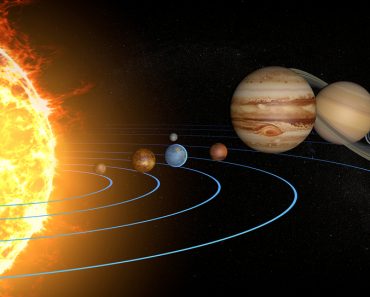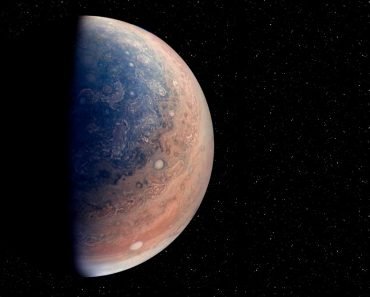Table of Contents (click to expand)
“The face of the sun is not without expression, but it tells us precious little of what is in its heart.”
– Armin J. Deutsch, Scientific American magazine, November 1948
Without the sun, life would not be possible on Earth. This is not a statement, but a fact, and we should all be aware of it. It is the sun that has kept the solar system bound together for billions of years, and it is responsible for all major astronomical phenomena that humanity has learned about to date. Nonetheless, we know very little about our closest and most important cosmic neighbour.
While sitting on a beach and bathing in sunshine, seldom do we ask ourselves what may be going on inside that big ball of fire. Well, if you’re curious to know about the interior of the Sun, you’ve come to the right place, as this article will explore the many mysteries of the Sun’s interior.
Recommended Video for you:
Chemical Composition Of The Sun
The sun is a gigantic sphere of glowing hot gases. In terms of the elements present, the sun is composed of two major gases—Hydrogen, which comprises about 71% of the sun’s mass, and Helium, which constitutes about 27.1% of the mass. Carbon, Nitrogen and Oxygen are the relatively heavier elements found in the star with a combined abundance of roughly 1.5% of the mass. The remaining 0.5% is comprised of elements such as Silicon, Magnesium, Neon, Iron, Sulphur and other heavier metals in trace amounts.
Layers Of The Sun
Scientists have studied the Sun in several ways, including ground-based telescopes and satellites, in order to obtain as much information as possible. For simplicity’s sake, they typically divide the sun into six main layers.

The photosphere is the deepest layer that we can observe directly. Granulations and bubbling gases cover most of the photosphere. The chromosphere is the next layer of the sun and is the source of solar flares. The next layer down is the corona, which cannot be seen with the naked eye but can be viewed using a coronagraph telescope. These layers comprise the region that has been seen by human eyes.
The core is the innermost region of the sun, where all the energy is generated through nuclear reactions. Naturally, it is rich in hydrogen and helium. The radiative zone lies between the core and the convection region and is packed full of cosmic rays and energy-filled photons. The convection zone stretches from depths of about 200,000 km right up to the visible surface of the star. It is on the surface of the convection zone that the photons are created; this top layer is called the photosphere.
How Did We Identify The Sun’s Composition?
When white light passes through a prism, it splits into its seven constituent colours (the seven colours of the rainbow), which is commonly known as the spectrum. When a similar experiment was performed on the sunlight by a German optician named Joseph Von Fraunhofer using a special instrument called a spectrometer, he found dark lines in the spectrum.

It was soon realized that these dark lines represented missing colours (wavelengths, to be more specific) of the spectrum, and these were missing because elements in and around the Sun were absorbing those specific wavelengths of light. Every element absorbs a specific wavelength of the spectrum corresponding to the electronic transmissions occurring in its atoms. These dark lines, therefore, indicated the presence of certain elements, such as hydrogen, calcium and sodium as they represented the wavelengths absorbed by these specific elements.
This was a very simple yet effective technique that laid the foundation for the development of more advanced instruments for measuring the composition of the sun. However, this approach does have its limitations. It only tells us about the constituents on the surface, but nothing about the composition of the Sun’s core!
So, What About The Core?
The emissions from the core of the sun mainly consist of particles, such as neutrinos, which travel in the backdrop of the light emitted by its surface and therefore cannot be detected with standard spectroscopic equipment. Thus, special instruments like the Super Kamiokande (Kamioka Observatory, Japan), which have extremely sensitive light sensors, were used to identify these particles. These particles confirmed the occurrence of Nuclear Fusion reactions in the Sun’s core, which is responsible for the emission of these particles.

Helioseismology
Another method used by scientists to study the solar interior is helioseismology. In it, scientists listen to the music of the Sun by studying sound waves emanating from the interior. The vibrations are recorded by NASA’s Solar and Heliospheric Observatory’s (SOHO) as different frequencies and converted into sound at Stanford Experimental Physics Lab using suitable techniques (more on solar sounds – NASA.gov)
The reflection of these sound waves off the inside of the photosphere causes the surface to pulsate and move very slightly; the rising and falling of the photosphere can be measured using specialized techniques to provide information on the density and motions of materials within the Sun.
A Final Word
In the last 200 years, we have been able to generate and analyze a reasonably good amount of data from the sun; at long last, we have a pretty good idea of what is going on. However, many mysteries of the Sun still remain, and there are some fascinating missions on the horizon that may help unravel them. NASA’s Parker Solar Probe is one such example.

The probe will swoop to within 4 million miles of the Sun’s surface, recording heat and radiation like no other spacecraft has done before. Launched in March 2018, it will provide new data on solar activity and make observations of the outer corona of the Sun. This mission will change our perception of the enormous celestial ball of fire that has given us life and may reveal all-new secrets about the sun’s core.
Another aspect to be considered here is that every star has a lifespan, and will eventually die. Our sun is no different. After it dies, it will contract under the weight of its own gravity. Fortunately, this won’t happen for several billion years and looking at our present trajectory as a species, none of us will be around when that happens!

References (click to expand)
- Layers of the Sun - NASA. The National Aeronautics and Space Administration
- Parker Solar Probe - NASA Blogs. The National Aeronautics and Space Administration
- Why Do We Want To Know More About Our Sun? - NASA. The National Aeronautics and Space Administration
- How do we study the Sun?. University College London












